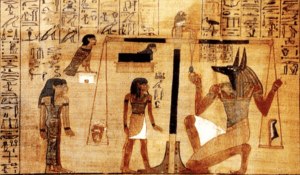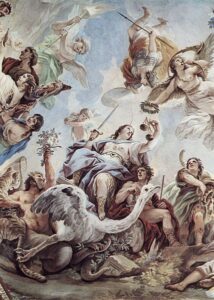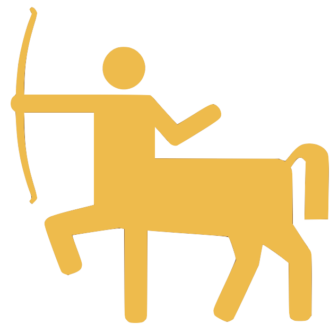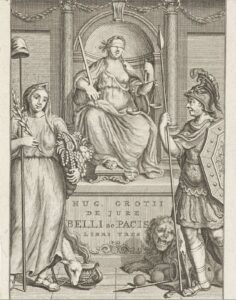Most people think of justice as something external; a situation is either just or unjust, fair or unfair. But justice is also about the way you judge. How you judge the outside world is a reflection of how just you are as a person.
To judge with justice is believed to be one of the top virtues, by philosophers, writers and artists of the ancient world. From Ancient Egypt to Ancient Greece and Rome, Justice has been personified by a goddess who not only belongs to the highest ranks of gods but whose symbolism is even sought by them. You could imagine what justice must have meant to men. This goddess I’m talking about is Lady Justice.
You have probably seen her but may not have paid too much attention; she could be a statue, an emblem or figurine to represent justice in the legal system worldwide. She holds a scale, a sword and at times she wears a blindfold. She has several other symbols, each of which bears powerful lessons. We’ll go through each of Lady Justices’ symbols to understand what it takes to judge with justice. We’ll also see how the evolution of her symbols reflect how we have developed our understanding of justice over time. But first, let’s go through…
The History of Lady Justice
Ancient Egypt – Ma’at
As of today, the oldest representation of judgement and justice is the balance scale found in ancient Mesopotamian and ancient Egyptian mythological art.
In the Ancient Egyptian Book of Death, which dates back to ~2400 BCE, the scale depicts the judgment of men’s soul after death. Ancient Egyptians believed that the soul is eternal and that after death, it receives a fate based on the integrity of its recently lived life.
The image shows the heart of the dead being weighed on a scale against an ostrich’s feather. This feather belongs to the goddess Ma’at.
 Weighing of the heart from the Papyrus of Ani
Weighing of the heart from the Papyrus of Ani
Ma’at is the goddess of cosmic order and social order. But that’s roughly speaking. What she truly represents is untranslatable (kind of like the Yin Yang); still, it would include truth, balance, order, harmony, law, justice, and morality – in the world of humans, of deities and the universe.
That’s pretty astronomical – so much that all other deities wanted their names associated with hers, including Pharaohs and Kings.
Ancient Greece – Themis & Dike
Fast Forward ~ 1500 years, Ancient Greece had a goddess named Themis whose representation is also untranslatable but overall covers divine order, law and justice.
Themis is a Titaness; Titans are the generation of gods that existed prior to the Olympian gods, which most people are familiar with today. Themis ensured that Zeus, the king of the Olympian gods, was well nursed. She also became one of his wives, and his counsellor, and assisted him in creating the world. Zeus carries out the action, but not before Themis’ advice (there is a larger thing at play behind the scenes).
Themis, having been one of the Delphic oracles, is also a prophetic goddess. In later renditions, Themis caries a balance scale, a sword and at times she wears a crown.
With Zeus, Themis had a daughter named Dike, whose representation is similar but more precise and closer to today’s idea of justice. Dike is the goddess of temporal law, justice and moral order.
Dike is characterized as holding a scale, a cornucopia, a tool to strike with, and wearing a wreath. Like her mother, Dike doesn’t exercise any power, she only advises Zeus, and he materializes. She’s also associated with time as she makes sure that things happen at the right moment. Like the Egyptian Ma’at, Dike also joins the functions of the underworld, judging the dead to send them off to their merited destination.
Ancient Rome – Justitia
As the Roman Empire takes over, Themis and Dike are replaced by the goddess Iustitia (Justitia).
Iustitia is Latin for “the quality of being just.” The word becomes “justice” in French and English. Its root ‘jus’ also forms the word “judging”.
Justitia was not really seen as part of the pantheon of gods, like Jupiter or Venus, nor was she worshipped religiously. She was mostly understood as the embodiment of the virtue of justice. Association and representation of this goddess were highly sought by monarchy; emperors, kings and queens.
Like her Greek counterpart, Justitia is portrayed with the balance scale, sword and at times a crown, however through the ages, especially the middle ages, increasingly more symbols become attributed to her, including the blindfold, which has a lasting impact and becomes one of the 3 most common symbols portrayed with her in modern times. The other symbols include measurement tools like the protractor and compass or a book of laws, that would replace the scale, though they were not as common.
Justitia (Lady Justice), engraver Willem de Broen
Justitia was also portrayed with an ostrich (which reminds us of Ma’at), lions, a snake or dog. She is often seen standing on top of a globe, an evil being, or a masked man. Artists often paired Justitia with Prudentia, the personification of prudence; Prudence always holds a mirror and snake.
When Christianity came into the picture, it adopted previous symbolism by portraying Christ with Justitia’s scale, sword and lion. Like Ma’at and Dike, the archangel Michael uses the scale to weigh the soul of humans at death, representing moral justice, while Jesus overlooks from above, standing on a globe with a sword nearby, representing world justice.
Today, Justitia is known as Lady Justice. She’s iconic across the world’s courtrooms, law offices, and anything that has to do with regulation and fair play.
Ok, done with the history and onto the juicy stuff:
Interpreting the Symbols of Justice
Let’s start with her most common symbol;
The Scale
The scale is an ancient device that weighs one object against another. Ancient Egyptians use it to portray the judgment of a man by weighing his heart against Ma’at’s ostrich feather. If the heart is equal or lighter than her feather, it is considered good and goes to the afterlife. If heavier, it goes to their version of hell.
This implies that there is an absolute amount of goodness that a person must meet to be considered good. To the ancient Egyptians, goodness and badness come in a continuum or scale.
It’s debated why the ostrich feather is emblematic of justice and equality, but some suggest that it is due to the feather’s symmetrical sides.
Humans have understood that it is really difficult to judge a person and that’s why they left it to the gods. We all sin and do good, but how much of each is what counts. A thief or a liar is a sinner. But what if their good outweighs their bad?
Let’s look at a scene that took place in a Parisian subway in the early morning hours. A drunk man is passed out on the bench, and a thief upon seeing this takes advantage of the situation and pickpockets him. He then leaves somewhere, outside the camera view. The drunk man still in bad shape decides to get up and falls in the subway tracks. A train is approaching the platform. A bystander does not do anything; maybe he does not want to risk his life, maybe he’s thinking ‘too bad you’re a drunk’, who knows, he does not help. And what do we see here? The thief runs back and tries to save his victim’s life!
Now, of course, this is just a snippet of his life – we could not judge his entire soul as good or bad – but this short video segment shows that all our sins and virtues must be accounted for when making an overall judgement of a person.
The weighing scale also reminds us that all sins and virtues come in degrees. All sins weigh differently; stealing is not the same gravity as killing. And each sin also comes in degrees; a white lie is not the same as a lie that jeopardizes people or parties. Lying once in a blue moon is not the same as lying all the time. Killing with intent is not the same gravity as killing by carelessness.
Though some types of judgment are not meant for humans to have, others are.
Making judgments is an essential part of living; it is required before acting. The scales of justice represent a crucial trait of proper judgment. They represent the ‘careful measuring of evidence’. This means that when judging a situation or a person, one needs to think like a scientist.
Your initial thought is not a fact, it’s YOUR theory and probably a bad one. Based on the scientific method, you would have started at “observation”, skipped all the following 5 steps and had drawn your conclusion…Bad scientist.
Sure you’re not going to make a scientific experiment for each judgment on something, but at least you should know that your judgment is far from being accurate.
First, you need to gather all evidence. Misjudging based on lack of evidence is something we do all too often, even for the littlest thing. For example the other day, I saw my boyfriend carelessly stuff my clean laundry in my drawer, and I accused him of being careless because it’s other peoples’ items. It turns out he does the same thing to his own clean laundry (and that I was the careless one with judgment)
This scenario sounds trivial but think of the times you judged a stranger as being racist or hateful because he/she was rude to you. What if this person spoke the exact same way with his children whom you know he adored? Now, will your previous judgement be the same?
Not only do we need to gather as much evidence as possible before making a judgement but we also need to be careful with how we gather that evidence. For example, imagine that you pass by a local bar and notice John drinking. Not enough data to judge him. A few months later, you go again and see him again. And another few months later, he’s there again! Now you have 3 data points spread over many months; John must be an alcoholic.
Now, you may be close to the truth, but were the days that you observed John drinking randomly chosen? Because had you realized that each time you observed John, you were on your way home from your Pilates class which happened to be on Friday evenings, you would have understood that “No, John is not an alcoholic, he’s just unwinding from a long work week”. A good scientist would have confirmed this by passing by the bar a few nights during the week, just to make sure.
The All-Seeing Eye and Clock
To accurately judge someone or a situation, one needs to keep a constant watch of people’s actions and intentions – a power humans don’t have. This is why we see the All-Seeing Eye around Justice.
Time is also a factor in judgment as time is revealing; more time provides more data. Time has been linked to the Greek goddesses of justice.
The longer you know someone or the more you study something, the better judgement you can have. I repeat: the better judgment you CAN have. Not “you WILL have”. Because you must be able to REASON properly. And taking the scientific approach of asking questions is one thing, but the integrity of your questions is something else. And that’s where Lady Justice’s blindfold comes in.
Prudentia’s Mirror and Snake
Prudentia is the goddess of Foresight through experience, reason and therefore, wisdom. ‘Prudentia’ comes from Latin ‘Providentia’ which means foresight. The All-Seeing Eye is also known as the Eye of Providence, which comes from ‘Providentia’.
Foresight is achieved through wisdom, and wisdom through self-reflection. The snake represents wisdom. You must be thinking “wait, I thought the snake was evil”. Remember, symbols have different meanings, even completely opposite meanings. They all depend on the context.
Prudentia’s mirror represents self-reflection. We have to reflect on our own actions and thoughts, our past and current situation, in order to form a just opinion and from there could we better analyze the external world and even predict certain outcomes. Justice has been linked to prophesy. We prevent the same mistake because we remember their consequence.
What you state or claim has to be done with caution. Play the scenario in your head first; “have I experienced it before? Were there the same ingredients? What was it like?…”
Prudentia is “prudence” in French and English and has come to mean caution. It is clear why Justice and Prudence go hand in hand. When you witness a situation of injustice due to biases or influences, it ought to be called out, in one form or another. This is where the sword comes in.
The Sword and The Lion
The sword symbolizes offence and defence. Held by Justitia, the sword represents the enforcement of justice as well as its protection. The sword also represents battle and shows that Justice is in a constant battle with ‘Injustice’.
The sword is one of Justitia’s’ earlier symbols. It may have been geared towards societal justice, but it ought to be applied to our daily lives as well. Not calling out an unjust situation makes you a … coward. It is true that some situations are a lot tougher than others and do require an immense amount of courage. Courage is associated with justice hence the lion often being portrayed with her.
The Masked Man or The Evil Man
Injustice ought to be your enemy. The unjust derives from pride, greed, wrath, envy, lust, gluttony, and sloth – also known as the 7 Cardinal Sins. But worse, is when injustice deceives; when it hides behind a mask and pretends it is justice. That’s why we often see Lady justice on top of a masked man or an evil-looking being.
Being crushed means to be taken down by it, to be made small. The lower level shows that it is beneath it. Goodness or Heaven is higher up. Evil or Hell is lower down.
 Fresco of Justitia (lady Justice) and her symbols,
Fresco of Justitia (lady Justice) and her symbols,
in the gallery of the Palazzo Medici-Riccardi in Florence
Justice is a virtue that’s above us, above humanity. She stands on top of the globe. She may be unreachable, but like the gods, she is a model to strive towards – at the societal level and personal level, in the way you treat others and in the way we think of others as they are directly related.
The Feminine and The Crown
Though Justice has also been portrayed as a male, her female representation has resonated more with the collective mind. The reason is likely to be that it is the female who gives birth.
Order comes before manifestation. Themis, the goddess of Justice came before Zeus, the king of gods; she helped nurture him before she married and became his advisor or his mind. Themis is the order – not just the moral order but also the natural order. She is the order that yields manifestation, aids manifestation and essentially is the mind of manifestation.
Like the Yin to the Yang, she is the background to the activity. She is the background of societies, communities and home. Whether the organization is just or unjust, she holds the invisible scale that humans base their actions on, sooner or later.
Justice sets the order. That’s why she wears a crown.
The crown symbolizes power, glory and authority. Where you see royalty, you will see lions as they also represent kingship and power.
And lastly, we have the Cornucopia.
The Cornucopia
The cornucopia is the mythical horn of plenty; it keeps giving and giving, thus symbolizing abundance, nourishment and prosperity. It is often associated with goddesses who provide and nurture like ‘Demeter the goddess of harvest’, ‘Fortuna the goddess of luck’ or ‘Abundantia the goddess of abundance’.
Justice’s cornucopia shows that her virtue nourishes the soul of humanity and will not stop as long as we continue to honour her. To take her path of prudence, self-reflection and impartiality is to forge the path of reasoning, the key to a virtuous life. Reasoning is the basis of all virtues, and of wisdom. Having wisdom is being endlessly rich.
We may never be entirely just in our judgment as we are humans after all and not gods; we are limited, fallible and sinful. But it shouldn’t stop us from striving to be just. After all, we’ve made it clear through the millennia that we are aware of the standards of justice; we’ve personified her and identified what she entails through symbolism and allegories. We’ve immortalized Lady Justice as the order of all things moral and natural, set her at the top of humanity and even the godly realm. The history of lady Justice shows that she is the order sought by societies and organizations, but first and foremost by the soul of man. To change the world around us, we first need to change the mind inside us.
The pursuit of justice starts within us.
Further Reading & Sources
- Resnik J., Curtis, D. (2011) Representing Justice: Invention, Controversy, and Rights in City-states and Democratic Courtrooms. New Haven & London: Yale University Press
- Jung, Carl G., Henderson, Joseph L., Jaffe, A., Jacobi, J., Freeman, J., von Franz, M. (1964) Man and His Symbols. New York, NY: Dell Publishing. p.237
- de Ville, J. Mythology and the Images of Justice. [Essay]. New York (NY): The Cardozo School of Law of Yeshiva University, Law & Litterature; 2011. https://repository.uwc.ac.za/xmlui/handle/10566/288
- Boatright, J. The History, Meaning, and Use of the Words Justice and Judge. 49 St. Mary’s L.J. 727 (2018). https://commons.stmarytx.edu/cgi/viewcontent.cgi?article=1013&context=thestmaryslawjournal
- Knox, Bradley A. “The Visual Rhetoric of Lady Justice: Understanding Jurisprudence Through ‘Metonymic Tokens'” Inquiries Journal. 2014. http://www.inquiriesjournal.com/articles/896/the-visual-rhetoric-of-lady-justice-understanding-jurisprudence-through-metonymic-tokens
- Lewis, Jone J. “Themis, Goddess of Justice” ThoughtCo. 25 Nov. 2019. https://www.thoughtco.com/themis-goddess-of-justice-3529225
- Mark, Joshua J. “The Egyptian Afterlife & The Feather of Truth.”Ancient.eu. 30 Mar. 2018. https://www.ancient.eu/article/42/the-egyptian-afterlife–the-feather-of-truth/
- Malandra, Ocean. “The Meanings of the Ostrich Totem” Classroom. 29 Sep. 2017. https://classroom.synonym.com/the-meanings-of-the-ostrich-totem-12084003.html













